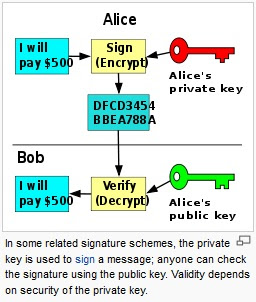Rsa Encryption Program In Java

Public key means the public gets it, to encrypt their message, and the owner of the private key (that is used to generate the public key) can read the encrypted message. For example: The server creates a private-public keypair, and sends the public to the client. The client want to change his password, so he enters the new password, then encrypts it with the public key. The public key cannot decrypt the encrypted string. Ps3 Prototype Game Cheats here.

Encryption and decryption. Alice and Bob would like to communicate in private. Alice uses RSA algorithm to generate her public and private keys. Bob uses Alice's public key (k, n) to encrypt message M: Alice receives E(M) and uses private key (d, n) to decrypt it. Therefore encryption strength totally lies on the key size and if we double or triple the key size, the strength of encryption increases exponentially. RSA keys can be typically 1024 or 2048 bits long, but experts believe that 1024 bit keys could be broken in the near future. C program for RSA asymmetric cryptographic.
The client sends the encrypted string to the server, where it uses the private key to decrypt strings, and decrypts the new password, then saves it. Amos License Not Found 11 4. Technically the private key is generated first, then with the private key, a public is generated. The private key cannot encrypt, the public cannot decrypt. Generally the decrypter key is called as private, and the public is used to encrypt. Public means, Anyone can see that key, you can even post it to facebook, but its only one purpose is, to encrypt something, that can be decrypted only by the private key holder. Private key, because it is his private key, no one should see it. Hello guys, I'm just exposed about RSA encryption.
So, can anyone help me to explain the codes? I mean what it did in every method such like: • public static void main(String [] args) throws Exception • public static KeyPair buildKeyPair() throws NoSuchAlgorithmException • public static byte[] encrypt(PrivateKey privateKey, String message) throws Exception • public static byte[] decrypt(PublicKey publicKey, byte [] encrypted) throws Exception Your explaination will help me to understand this.thanks.
Dragon Magazine Torrent Pdf Writer. Popular topics: RSA encryption in Java We introduced the notion of, in which a key needed to encrypt data is made public, but the corresponding key needed to decrypt it is kept private, for example in a file on the server to which clients connect. In principle, such a system solves the problem of how to send a temporary encryption key securely to the server when opening a secure connection *.
A very common asymmetric encryption system is RSA, named after inventors Rivest, Shamir & Adleman. *If we just used a system such as AES on its own, we'd have the problem of how the two parties agree on the key in advance. This is sometimes possible, but usually, we want to transmit a temporary key at the moment of connecting. Generally, we use an asymmetric encryption system such as RSA to transmit the secret key, then for the rest of the conversation, use a regular symmetric encryption system using that secret key. Basic algorithm and terminology RSA encryption and decryption are essentially mathematical operations. They are what are termed exponentiation, modulo a particular number.
Because of this, RSA keys actually consist of numbers involved in this calculation, as follows: • the public key consists of the modulus and a public exponent; • the private key consists of that same modulus plus a private exponent. Those interested in more details of the should see this separate page.
Creating an RSA key pair in Java As a one-off process, we need to generate an RSA key pair that from then on, we'll use for all conversations between our clients and server. Creating an RSA key pair essentially consists of picking a modulus, which is based on two random primes intended to be unique to that key pair, picking a public exponent (in practice, the common exponent 65537 is often used), then calculating the corresponding private exponent given the modulus and public exponent. Java provides the KeyPairGenerator class for performing this task. The essential idea is as follows: • we create an instance of KeyPairGenerator suitable for generating RSA keys; • we initialise the generator, telling it the bit length of the modulus that we require (see below); • we call genKeyPair(), which eventually returns a KeyPair object; • we call getPublic() and getPrivate() on the latter to pull out the public and private keys. The code looks as follows. KeyPairGenerator kpg = KeyPairGenerator.getInstance('RSA'); kpg.initialize(2048); KeyPair kp = kpg.genKeyPair(); Key publicKey = kp.getPublic(); Key privateKey = kp.getPrivate(); Notice that we specify a key length of 2048 bits. Common values are 1024 or 2048.